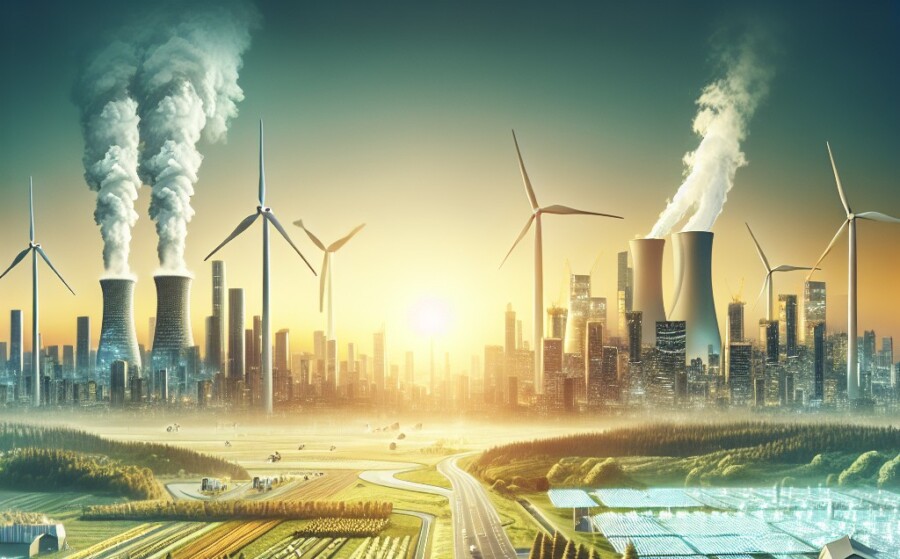The COP28 climate summit is currently taking place in Dubai, where delegates are discussing various solutions to combat climate change. While the Earth’s climate is changing rapidly and urgent action is needed, there is hope for the future. Let’s take a look at five concrete solutions that are being discussed at the summit.
Firstly, it is crucial to cut down on burning fossil fuels such as coal, oil, and gas. These fuels are responsible for over three-quarters of global greenhouse gas emissions. Many governments, scientists, and campaigners are pushing for a global agreement to phase out these polluting fuels. Although global demand for fossil fuels is expected to peak before 2030, this alone is not enough to meet the climate goals set in the Paris Agreement.
Secondly, renewable energy sources like wind and solar power offer a promising alternative to fossil fuels. The cost of renewables has been decreasing, leading to a surge in their usage worldwide. By 2030, wind and solar energy could supply more than a third of all electricity, up from the current 12%. However, other technologies like battery storage, nuclear power, and “green” hydrogen energy will also be necessary to fill in the gaps when renewable sources are not available.
Thirdly, switching to electric vehicles (EVs) can significantly reduce greenhouse gas emissions from road transport. EVs have the potential to cut emissions by around two-thirds compared to petrol and diesel cars. As the electricity used to power EVs becomes cleaner, their emissions advantage will only increase. The sales of EVs are rapidly increasing, and it is projected that they could account for 18% of new car sales in 2023. This shift towards EVs could be accelerated by their decreasing costs, making them more affordable than traditional cars in the near future.
Another important solution is to tackle methane emissions, which contribute to around 30% of global warming. Methane is a potent warming gas, although it remains in the atmosphere for a shorter period compared to carbon dioxide. Key sources of methane emissions include agriculture, fossil fuel production, and waste. Over 150 countries have committed to reducing methane emissions by 30% by 2030, with China being a notable exception.
Lastly, capturing carbon dioxide (CO2) from the atmosphere or directly from its source is crucial to limit warming to 1.5 degrees Celsius. The natural world already absorbs over half of CO2 emissions, but human activities like deforestation and warming the seas are hindering this process. Restoring ecosystems and implementing industrial carbon capture and storage technologies are potential solutions, but they are still emerging and expensive.
In conclusion, the COP28 climate summit is focusing on concrete solutions to combat climate change. Cutting fossil fuel usage, increasing renewable energy sources, transitioning to electric vehicles, reducing methane emissions, and capturing carbon are all crucial steps in mitigating the effects of climate change. While there are challenges to overcome, there is hope that these solutions can help limit global warming and protect the planet for future generations
Original news source: Are the solutions to fight climate change making progress? (BBC)
Listen:
Slow
Normal
Fast
Vocabulary:
| 1 | fossil fuels | Fuels such as coal, oil, and gas that release carbon dioxide when burned |
| 2 | greenhouse gas emissions | The release of gases that trap heat in the Earth’s atmosphere, leading to climate change |
| 3 | renewable energy sources | Sources of energy that can be replenished naturally, such as wind and solar power |
| 4 | electric vehicles (EVs) | Vehicles powered by electricity instead of gasoline or diesel |
| 5 | methane emissions | The release of methane gas into the atmosphere, contributing to global warming |
| 6 | carbon dioxide (CO2) | A gas that is released when fossil fuels are burned and contributes to global warming |
| 7 | global warming | The increase in the Earth’s average temperature due to human activities |
| 8 | deforestation | The removal of trees from an area, leading to loss of habitat and increased carbon dioxide levels |
| 9 | industrial carbon capture and storage | Technologies that capture carbon dioxide emissions and store them underground |
| 10 | mitigating | Reducing or lessening the impact or severity of something |
| 11 | COP28 climate summit | An international conference where world leaders discuss climate change and potential solutions |
| 12 | concrete solutions | Specific and practical ways to address a problem or issue |
| 13 | climate change | Long-term changes in temperature and weather patterns caused by human activities |
| 14 | Paris Agreement | An agreement within the United Nations Framework Convention on Climate Change to limit global warming |
| 15 | future generations | Future individuals or generations that will inherit the Earth and its environmental challenges |
Group or Classroom Activities
Warm-up Activities:
– News Summary
Instructions:
1. Divide the students into pairs.
2. Give each pair a copy of the article.
3. Set a time limit (e.g. 10 minutes) for the students to read the article and discuss the main points.
4. After the time limit, ask each pair to summarize the article in their own words.
5. Have pairs take turns sharing their summaries with the class.
– Opinion Poll
Instructions:
1. Divide the students into small groups.
2. Assign each group a solution mentioned in the article (e.g. cutting fossil fuel usage, increasing renewable energy sources, etc.).
3. Give the groups a few minutes to discuss and brainstorm their opinions on the assigned solution.
4. Have each group create an opinion poll with a few questions related to their solution.
5. Have the groups take turns administering their opinion polls to the rest of the class.
6. After all the polls have been completed, discuss the results as a class.
– Vocabulary Pictionary
Instructions:
1. Write down key vocabulary words from the article on separate pieces of paper.
2. Divide the students into two teams.
3. Choose one student from each team to come to the front of the class.
4. Show the chosen students a vocabulary word without showing the rest of the class.
5. The chosen students must draw a picture to represent the word, while their teams try to guess what the word is.
6. The first team to guess correctly earns a point.
7. Repeat the process with new students and words until all the vocabulary words have been used.
– Pros and Cons
Instructions:
1. Divide the students into pairs or small groups.
2. Assign each pair/group a solution mentioned in the article (e.g. cutting fossil fuel usage, increasing renewable energy sources, etc.).
3. Have the pair/group discuss the pros and cons of their assigned solution.
4. After a few minutes, ask each pair/group to share their pros and cons with the class.
5. Encourage a class discussion on the different solutions and their potential benefits and drawbacks.
– Future Predictions
Instructions:
1. Have the students work individually.
2. Ask each student to choose one of the solutions mentioned in the article.
3. Instruct the students to write a short paragraph predicting what the future will look like if their chosen solution is successfully implemented.
4. After the students have finished writing, have them share their predictions with a partner.
5. Encourage the partners to discuss and compare their predictions.
6. As a class, have a few students share their predictions and discuss the different possibilities.
Comprehension Questions:
1. Why is it crucial to cut down on burning fossil fuels?
2. What are some renewable energy sources that can be alternatives to fossil fuels?
3. How much of global greenhouse gas emissions do fossil fuels account for?
4. How much of the world’s electricity could be supplied by wind and solar energy by 2030?
5. How much can greenhouse gas emissions be reduced by switching to electric vehicles?
6. What are some key sources of methane emissions?
7. What is one potential solution to limit warming to 1.5 degrees Celsius?
8. What are some challenges to implementing these concrete solutions to combat climate change?
Go to answers ⇩
Listen and Fill in the Gaps:
The COP28 (1)______ summit is currently taking place in Dubai, where delegates are discussing various solutions to (2)______ climate change. While the Earth’s climate is changing rapidly and urgent action is needed, there is hope for the future. Let’s take a look at five concrete solutions that are being discussed at the summit.
Firstly, it is crucial to cut down on (3)______ fossil fuels such as coal, oil, and gas. These fuels are responsible for over three-quarters of global greenhouse gas emissions. Many (4)______, scientists, and campaigners are pushing for a global agreement to phase out these polluting fuels. Although global demand for fossil fuels is expected to peak before 2030, this alone is not enough to meet the climate goals set in the Paris Agreement.
Secondly, renewable energy sources like wind and solar power offer a promising alternative to fossil fuels. The cost of renewables has been decreasing, leading to a surge in their usage worldwide. By 2030, wind and solar (5)______ could supply more than a third of all electricity, up from the current 12%. However, other technologies like battery storage, (6)______ power, and “green” hydrogen energy will also be necessary to fill in the gaps when renewable sources are not available.
Thirdly, switching to electric vehicles (EVs) can significantly reduce (7)______ gas emissions from road transport. EVs have the potential to cut emissions by around two-thirds compared to petrol and diesel cars. As the electricity used to power EVs becomes (8)______, their emissions advantage will only increase. The sales of EVs are rapidly increasing, and it is projected that they could account for 18% of new car sales in 2023. This shift towards EVs could be accelerated by their decreasing costs, (9)______ them more affordable than traditional cars in the near future.
Another important solution is to (10)______ methane (11)______, which contribute to around 30% of global warming. (12)______ is a potent warming gas, although it remains in the atmosphere for a shorter period compared to carbon dioxide. Key sources of methane emissions include agriculture, fossil fuel production, and waste. Over 150 countries have committed to reducing methane emissions by 30% by 2030, with China being a notable exception.
Lastly, capturing carbon dioxide (CO2) from the atmosphere or directly from its source is crucial to limit warming to 1.5 degrees Celsius. The (13)______ world already absorbs over half of CO2 emissions, but human (14)______ like deforestation and warming the seas are hindering this process. Restoring ecosystems and implementing industrial carbon capture and storage technologies are potential solutions, but they are still emerging and (15)______.
In conclusion, the COP28 climate summit is focusing on concrete solutions to combat climate change. Cutting fossil fuel usage, increasing renewable energy sources, transitioning to electric vehicles, reducing (16)______ emissions, and capturing carbon are all crucial steps in mitigating the effects of climate change. While there are challenges to overcome, there is hope that these solutions can help limit global warming and protect the planet for future generations
Go to answers ⇩
Discussion Questions:
Students can ask a partner these questions, or discuss them as a group.
1. What is your opinion on the use of fossil fuels and the need to phase them out?
2. How would you feel if wind and solar energy supplied a third of all electricity by 2030?
3. Do you like the idea of driving an electric vehicle? Why or why not?
4. Do you think it is important for countries to commit to reducing methane emissions? Why or why not?
5. How would you feel if carbon capture and storage technologies became more widely implemented?
6. What is your opinion on the role of governments in combatting climate change?
7. How do you think the decreasing cost of renewable energy sources will impact their usage in the future?
8. Do you think the transition to electric vehicles will happen quickly or slowly? Why?
9. How would you feel if your country implemented stricter regulations on greenhouse gas emissions?
10. What is your opinion on the role of individuals in addressing climate change?
11. How do you think the COP28 climate summit will impact global efforts to combat climate change?
12. Do you think the solutions discussed at the summit are enough to mitigate the effects of climate change? Why or why not?
13. How would you feel if your country invested more in renewable energy infrastructure?
14. What is your opinion on the use of nuclear power as a renewable energy source?
15. How do you think climate change will impact future generations?
Individual Activities
Vocabulary Meanings:
Match each word to its meaning.
Words:
1. fossil fuels
2. greenhouse gas emissions
3. renewable energy sources
4. electric vehicles (EVs)
5. methane emissions
6. carbon dioxide (CO2)
7. global warming
8. deforestation
9. industrial carbon capture and storage
10. mitigating
11. COP28 climate summit
12. concrete solutions
13. climate change
14. Paris Agreement
15. future generations
Meanings:
(A) Reducing or lessening the impact or severity of something
(B) A gas that is released when fossil fuels are burned and contributes to global warming
(C) Long-term changes in temperature and weather patterns caused by human activities
(D) An agreement within the United Nations Framework Convention on Climate Change to limit global warming
(E) Fuels such as coal, oil, and gas that release carbon dioxide when burned
(F) The release of gases that trap heat in the Earth’s atmosphere, leading to climate change
(G) Sources of energy that can be replenished naturally, such as wind and solar power
(H) The removal of trees from an area, leading to loss of habitat and increased carbon dioxide levels
(I) Specific and practical ways to address a problem or issue
(J) The release of methane gas into the atmosphere, contributing to global warming
(K) Technologies that capture carbon dioxide emissions and store them underground
(L) Vehicles powered by electricity instead of gasoline or diesel
(M) Future individuals or generations that will inherit the Earth and its environmental challenges
(N) An international conference where world leaders discuss climate change and potential solutions
(O) The increase in the Earth’s average temperature due to human activities
Go to answers ⇩
Multiple Choice Questions:
1. What is the main focus of the COP28 climate summit?
(a) Analyzing the causes of climate change
(b) Debating the existence of climate change
(c) Discussing solutions to combat climate change
(d) Promoting the use of fossil fuels
2. Which of the following is NOT a solution being discussed at the summit?
(a) Increasing the use of renewable energy sources
(b) Phasing out fossil fuels
(c) Implementing carbon capture and storage technologies
(d) Encouraging the use of coal, oil, and gas
3. What percentage of global greenhouse gas emissions are caused by burning fossil fuels?
(a) Around half
(b) Over three-quarters
(c) Less than a quarter
(d) None
4. What is the projected percentage of wind and solar energy in the global electricity supply by 2030?
(a) Less than 10%
(b) More than a third
(c) Around 50%
(d) None
5. How much can electric vehicles (EVs) reduce greenhouse gas emissions compared to petrol and diesel cars?
(a) Around two-thirds
(b) No reduction
(c) Half
(d) Double
6. What is a key source of methane emissions?
(a) Wind energy
(b) Nuclear power
(c) Agriculture
(d) Battery storage
7. How many countries have committed to reducing methane emissions by 30% by 2030?
(a) None
(b) Only China
(c) Less than 10
(d) Over 150
8. What is one potential solution to capturing carbon dioxide (CO2) from the atmosphere?
(a) Increasing fossil fuel production
(b) Encouraging deforestation
(c) Ignoring the issue of carbon emissions
(d) Implementing industrial carbon capture and storage technologies
Go to answers ⇩
True or False Questions:
1. Many governments, scientists, and campaigners are pushing for a global agreement to phase out fossil fuels.
2. Capturing carbon dioxide (CO2) from the atmosphere or directly from its source is not crucial to limit warming to 1.5 degrees Celsius.
3. Renewable energy sources like wind and solar power offer a promising alternative to fossil fuels.
4. Burning fossil fuels is responsible for less than three-quarters of global greenhouse gas emissions.
5. Electric vehicles (EVs) do not have the potential to cut emissions by around two-thirds compared to petrol and diesel cars.
6. The COP28 climate summit is currently taking place in Dubai.
7. Delegates at the summit are not discussing various solutions to combat climate change.
8. Methane emissions contribute to around 30% of global warming.
Go to answers ⇩
Write a Summary:
Write a summary of this news article in two sentences.
Check your writing now with the best free AI for English writing!
Writing Questions:
Answer the following questions. Write as much as you can for each answer.
Check your answers with our free English writing assistant!
1. What are the key sources of methane emissions?
2. How much of global greenhouse gas emissions are caused by burning fossil fuels?
3. What are some potential solutions for capturing carbon dioxide?
4. How much of global electricity could be supplied by wind and solar energy by 2030?
5. Which country has not committed to reducing methane emissions by 30% by 2030?
Answers
Comprehension Question Answers:
1. Why is it crucial to cut down on burning fossil fuels?
– It is crucial to cut down on burning fossil fuels because they are responsible for over three-quarters of global greenhouse gas emissions.
2. What are some renewable energy sources that can be alternatives to fossil fuels?
– Some renewable energy sources that can be alternatives to fossil fuels are wind and solar power.
3. How much of global greenhouse gas emissions do fossil fuels account for?
– Fossil fuels account for over three-quarters of global greenhouse gas emissions.
4. How much of the world’s electricity could be supplied by wind and solar energy by 2030?
– By 2030, wind and solar energy could supply more than a third of all electricity.
5. How much can greenhouse gas emissions be reduced by switching to electric vehicles?
– Greenhouse gas emissions can be reduced by around two-thirds by switching to electric vehicles compared to petrol and diesel cars.
6. What are some key sources of methane emissions?
– Some key sources of methane emissions include agriculture, fossil fuel production, and waste.
7. What is one potential solution to limit warming to 1.5 degrees Celsius?
– One potential solution to limit warming to 1.5 degrees Celsius is capturing carbon dioxide (CO2) from the atmosphere or directly from its source.
8. What are some challenges to implementing these concrete solutions to combat climate change?
– Some challenges to implementing these concrete solutions to combat climate change include the cost of implementing new technologies, resistance from industries dependent on fossil fuels, and the need for international cooperation and agreements.
Go back to questions ⇧
Listen and Fill in the Gaps Answers:
(1) climate
(2) combat
(3) burning
(4) governments
(5) energy
(6) nuclear
(7) greenhouse
(8) cleaner
(9) making
(10) tackle
(11) emissions
(12) Methane
(13) natural
(14) activities
(15) expensive
(16) methane
Go back to questions ⇧
Vocabulary Meanings Answers:
1. fossil fuels
Answer: (E) Fuels such as coal, oil, and gas that release carbon dioxide when burned
2. greenhouse gas emissions
Answer: (F) The release of gases that trap heat in the Earth’s atmosphere, leading to climate change
3. renewable energy sources
Answer: (G) Sources of energy that can be replenished naturally, such as wind and solar power
4. electric vehicles (EVs)
Answer: (L) Vehicles powered by electricity instead of gasoline or diesel
5. methane emissions
Answer: (J) The release of methane gas into the atmosphere, contributing to global warming
6. carbon dioxide (CO2)
Answer: (B) A gas that is released when fossil fuels are burned and contributes to global warming
7. global warming
Answer: (O) The increase in the Earth’s average temperature due to human activities
8. deforestation
Answer: (H) The removal of trees from an area, leading to loss of habitat and increased carbon dioxide levels
9. industrial carbon capture and storage
Answer: (K) Technologies that capture carbon dioxide emissions and store them underground
10. mitigating
Answer: (A) Reducing or lessening the impact or severity of something
11. COP28 climate summit
Answer: (N) An international conference where world leaders discuss climate change and potential solutions
12. concrete solutions
Answer: (I) Specific and practical ways to address a problem or issue
13. climate change
Answer: (C) Long-term changes in temperature and weather patterns caused by human activities
14. Paris Agreement
Answer: (D) An agreement within the United Nations Framework Convention on Climate Change to limit global warming
15. future generations
Answer: (M) Future individuals or generations that will inherit the Earth and its environmental challenges
Go back to questions ⇧
Multiple Choice Answers:
1. What is the main focus of the COP28 climate summit?
Answer: (c) Discussing solutions to combat climate change
2. Which of the following is NOT a solution being discussed at the summit?
Answer: (a) Increasing the use of renewable energy sources
3. What percentage of global greenhouse gas emissions are caused by burning fossil fuels?
Answer: (b) Over three-quarters
4. What is the projected percentage of wind and solar energy in the global electricity supply by 2030?
Answer: (b) More than a third
5. How much can electric vehicles (EVs) reduce greenhouse gas emissions compared to petrol and diesel cars?
Answer: (a) Around two-thirds
6. What is a key source of methane emissions?
Answer: (c) Agriculture
7. How many countries have committed to reducing methane emissions by 30% by 2030?
Answer: (d) Over 150
8. What is one potential solution to capturing carbon dioxide (CO2) from the atmosphere?
Answer: (d) Implementing industrial carbon capture and storage technologies
Go back to questions ⇧
True or False Answers:
1. Many governments, scientists, and campaigners are pushing for a global agreement to phase out fossil fuels. (Answer: True)
2. Capturing carbon dioxide (CO2) from the atmosphere or directly from its source is not crucial to limit warming to 1.5 degrees Celsius. (Answer: False)
3. Renewable energy sources like wind and solar power offer a promising alternative to fossil fuels. (Answer: True)
4. Burning fossil fuels is responsible for less than three-quarters of global greenhouse gas emissions. (Answer: False)
5. Electric vehicles (EVs) do not have the potential to cut emissions by around two-thirds compared to petrol and diesel cars. (Answer: False)
6. The COP28 climate summit is currently taking place in Dubai. (Answer: True)
7. Delegates at the summit are not discussing various solutions to combat climate change. (Answer: False)
8. Methane emissions contribute to around 30% of global warming. (Answer: True)
Go back to questions ⇧













